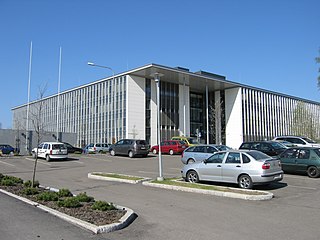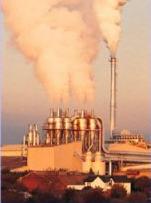
The Finnish Meteorological Institute is the government agency responsible for gathering and reporting weather data and forecasts in Finland. It is a part of the Ministry of Transport and Communications but it operates semi-autonomously.

The Air Resources Laboratory (ARL) is an air quality and climate laboratory in the Office of Oceanic and Atmospheric Research (OAR) which is an operating unit within the National Oceanic and Atmospheric Administration (NOAA) in the United States. It is one of seven NOAA Research Laboratories (RLs). In October 2005, the Surface Radiation Research Branch of the ARL was merged with five other NOAA labs to form the Earth System Research Laboratory.

The Norwegian Institute for Air Research or NILU is one of the leading specialized scientific laboratories in Europe researching issues related to air pollution, climate change and health. NILU has a staff of scientists, engineers and technicians with specialized expertise for working on air pollution problems. The staff do more than two hundred projects annually for research councils, industries, international banks and local, national and international authorities and organizations. Its director since 2009 is Kari Nygaard.

The National Centre of Scientific Research "Demokritos" is a research center in Greece, employing over 1,000 researchers, engineers, technicians and administrative personnel. It focuses on several fields of natural sciences and engineering and hosts laboratory facilities.

Atmospheric dispersion modeling is the mathematical simulation of how air pollutants disperse in the ambient atmosphere. It is performed with computer programs that include algorithms to solve the mathematical equations that govern the pollutant dispersion. The dispersion models are used to estimate the downwind ambient concentration of air pollutants or toxins emitted from sources such as industrial plants, vehicular traffic or accidental chemical releases. They can also be used to predict future concentrations under specific scenarios. Therefore, they are the dominant type of model used in air quality policy making. They are most useful for pollutants that are dispersed over large distances and that may react in the atmosphere. For pollutants that have a very high spatio-temporal variability and for epidemiological studies statistical land-use regression models are also used.

The Royal Netherlands Meteorological Institute is the Dutch national weather forecasting service, which has its headquarters in De Bilt, in the province of Utrecht, Netherlands.

The Air Quality Modeling Group (AQMG) is in the U.S. EPA's Office of Air and Radiation (OAR) and provides leadership and direction on the full range of air quality models, air pollution dispersion models and other mathematical simulation techniques used in assessing pollution control strategies and the impacts of air pollution sources.
The UK Dispersion Modelling Bureau is part of the Met Office which is the UK's national weather and meteorological service. The meteorologists in the bureau are among the UK's leading experts in areas such:

Roadway air dispersion modeling is the study of air pollutant transport from a roadway or other linear emitter. Computer models are required to conduct this analysis, because of the complex variables involved, including vehicle emissions, vehicle speed, meteorology, and terrain geometry. Line source dispersion has been studied since at least the 1960s, when the regulatory framework in the United States began requiring quantitative analysis of the air pollution consequences of major roadway and airport projects. By the early 1970s this subset of atmospheric dispersion models were being applied to real world cases of highway planning, even including some controversial court cases.
Germany has an air pollution control regulation titled "Technical Instructions on Air Quality Control" and commonly referred to as the TA Luft.
The National Atmospheric Release Advisory Center (NARAC) is located at the University of California's Lawrence Livermore National Laboratory. It is a national support and resource center for planning, real-time assessment, emergency response, and detailed studies of incidents involving a wide variety of hazards, including nuclear, radiological, chemical, biological, and natural emissions.
NERI, the National Environmental Research Institute of Denmark was an independent research institute under the Aarhus University. NERI undertook scientific consultancy work and monitoring of nature and the environment as well as applied and strategic research. NERI’s primary task was to establish a scientific foundation for environmental policy decisions.
The ADMS 3 is an advanced atmospheric pollution dispersion model for calculating concentrations of atmospheric pollutants emitted both continuously from point, line, volume and area sources, or intermittently from point sources. It was developed by Cambridge Environmental Research Consultants (CERC) of the UK in collaboration with the UK Meteorological Office, National Power plc and the University of Surrey. The first version of ADMS was released in 1993. The version of the ADMS model discussed on this page is version 3 and was released in February 1999. It runs on Microsoft Windows. The current release, ADMS 5 Service Pack 1, was released in April 2013 with a number of additional features.
The AERMOD atmospheric dispersion modeling system is an integrated system that includes three modules:
The NAME atmospheric pollution dispersion model was first developed by the UK's Met Office in 1986 after the nuclear accident at Chernobyl, which demonstrated the need for a method that could predict the spread and deposition of radioactive gases or material released into the atmosphere.
Air pollution dispersion – distribution of air pollution into the atmosphere. Air pollution is the introduction of particulates, biological molecules, or other harmful materials into Earth's atmosphere, causing disease, death to humans, damage to other living organisms such as food crops, or the natural or built environment. Air pollution may come from anthropogenic or natural sources. Dispersion refers to what happens to the pollution during and after its introduction; understanding this may help in identifying and controlling it. Air pollution dispersion has become the focus of environmental conservationists and governmental environmental protection agencies of many countries regarding air pollution control.
The Czech Hydrometeorological Institute (CHMI) is within the Environmental Ministry of the Czech Republic. The head office and centralized workplaces of the CHMI, including the data processing, telecommunication and technical services, are located at the Institute's own campus in Prague. The CHMI has five major divisions:
ISC3 model is a popular steady-state Gaussian plume model which can be used to assess pollutant concentrations from a wide variety of sources associated with an industrial complex.
SAFE AIR is an advanced atmospheric pollution dispersion model for calculating concentrations of atmospheric pollutants emitted both continuously or intermittently from point, line, volume and area sources. It adopts an integrated Gaussian puff modeling system. SAFE AIR consists of three main parts: the meteorological pre-processor WINDS to calculate wind fields, the meteorological pre-processor ABLE to calculate atmospheric parameters and a lagrangian multisource model named P6 to calculate pollutant dispersion. SAFE AIR is included in the online Model Documentation System (MDS) of the European Environment Agency (EEA) and of the .Italian Agency for the Protection of the Environment (APAT).







